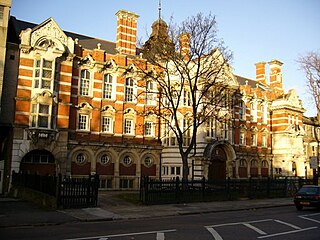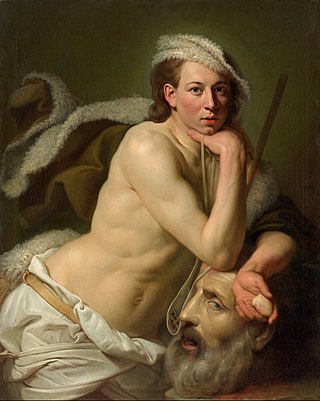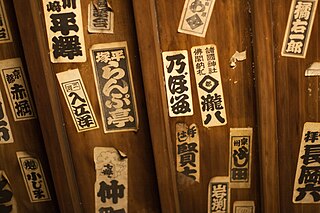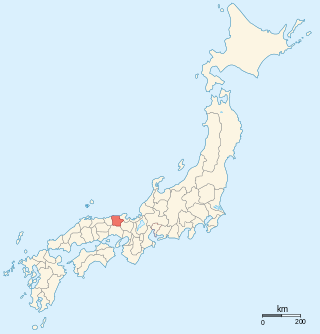Related Research Articles

In European academic traditions, fine art is made primarily for aesthetics or creative expression, distinguishing it from decorative art or applied art, which also has to serve some practical function, such as pottery or most metalwork. In the aesthetic theories developed in the Italian Renaissance, the highest art was that which allowed the full expression and display of the artist's imagination, unrestricted by any of the practical considerations involved in, say, making and decorating a teapot. It was also considered important that making the artwork did not involve dividing the work between different individuals with specialized skills, as might be necessary with a piece of furniture, for example. Even within the fine arts, there was a hierarchy of genres based on the amount of creative imagination required, with history painting placed higher than still life.

The Royal Academy of Arts (RA) is an art institution based in Burlington House on Piccadilly in London, England. Founded in 1768, it has a unique position as an independent, privately funded institution led by eminent artists and architects. Its purpose is to promote the creation, enjoyment and appreciation of the visual arts through exhibitions, education and debate.

Gillian Ayres was an English painter. She is best known for abstract painting and printmaking using vibrant colours, which earned her a Turner Prize nomination.

Camberwell College of Arts is a public tertiary art school in Camberwell, in London, England. It is one of the six constituent colleges of the University of the Arts London. It offers further and higher education programmes, including postgraduate and PhD awards. The college has retained single degree options within Fine Art, offering specialist Bachelor of Arts courses in painting, sculpture, photography and drawing. It also runs graduate and postgraduate courses in art conservation and fine art as well as design courses such as graphic design, illustration and 3D design. It has been ranked as the top British art school by The Times.
Eileen Cooper is a British artist, known primarily as a painter and printmaker.

Toko Shinoda was a Japanese artist. Shinoda is best known for her abstract sumi ink paintings and prints. Shinoda’s oeuvre was predominantly executed using the traditional means and media of East Asian calligraphy, but her resulting abstract ink paintings and prints express a nuanced visual affinity with the bold black brushstrokes of mid-century Abstract Expressionism. In the postwar New York art world, Shinoda’s works were exhibited at the prominent art galleries including the Bertha Schaefer Gallery and the Betty Parsons Gallery. Shinoda remained active all her life and in 2013, she was honored with a touring retrospective exhibition at four venues in Gifu Prefecture to celebrate her 100th birthday. Shinoda has had solo exhibitions at the Seibu Museum at Art, Tokyo in 1989, the Museum of Fine Arts, Gifu in 1992, the Singapore Art Museum in 1996, the Hara Museum of Contemporary Art in 2003, the Sogo Museum of Art in 2021, the Tokyo Opera City Art Gallery in 2022, and among many others. Shinoda's works are in the collection of the Albright-Knox Art Gallery, the Art Institute of Chicago, the British Museum, the Brooklyn Museum, the Harvard Art Museums, the Metropolitan Museum of Art, the Museum of Fine Arts, Boston, the National Museum of Modern Art, Tokyo, the Singapore Art Museum, the Smithsonian Institution, the Solomon R. Guggenheim Museum, the National Gallery of Victoria, and other leading museums of the world. Shinoda was also a prolific writer published more than 20 books.

Matsubara Naoko is a Japanese-Canadian artist.
Chizuko Yoshida was a Japanese modernist artist, whose work reflected the development of art in Japan following World War II. She was noted for providing a connective link between widespread modern art movements and traditional Japanese imagery.

Johan Joseph Zoffany was a German neoclassical painter who was active mainly in England, Italy and India. His works appear in many prominent British collections, including the National Gallery, the Tate Gallery and the Royal Collection, as well as institutions in continental Europe, India, the United States and Australia. His name is sometimes spelled Zoffani or Zauffelij.

Charles William Bartlett was an English painter and printmaker who settled in Hawaii.

Senjafuda are votive slips, stickers or placards posted on the gates or buildings of Shinto shrines and Buddhist temples in Japan. Unlike ofuda, which bear the name of the shrine, senjafuda bear the name of the worshipper, and can be purchased pre-printed with common names at temples and shrines throughout Japan, as well as at stationery stores and video game centres. Senjafuda were originally made from wooden slats, but have been made of paper since the Edo period.

Elizabeth Keith was a Scottish artist and writer. She was a print-maker and watercolorist whose works were significantly influenced by her travels to Japan, China, Korea and the Philippines.

Utagawa Toyoharu was a Japanese artist in the ukiyo-e genre, known as the founder of the Utagawa school and for his uki-e pictures that incorporated Western-style geometrical perspective to create a sense of depth.
Yasuhide Kobashi was a Japanese woodblock print artist, painter, sculptor and stage designer. He was born in Kojima in Okayama Prefecture. His father was a ceramic artist and head of the Kyoto Industrial Craft Company. Kobashi learned printmaking from the sōsaku hanga master Unichi Hiratsuka (1895–1997). In 1955, Kobashi graduated from the Kyoto College of Crafts and Textiles, and in 1959, he moved to New York City. Nelson Rockefeller was Kobashi's patron, and acquired one of the artist's sculptures for the New York State Executive Mansion in Albany.
Sarah Brayer is an American artist who works in both Japan and the United States. She is internationally known for her poured washi paperworks, aquatint and woodblock prints. In 2013 Japan's Ministry of Culture awarded Sarah its Bunkacho Chokan Hyosho for dissemination of Japanese culture abroad through her creations in Echizen washi. She currently resides in Kyoto, Japan and New York, U.S.A.

Uchiwa-e (団扇絵) are a genre of Japanese ukiyo-e woodblock print, which appear on rigid, paddle-shaped hand fans known as uchiwa (団扇). Ovoid images matching the outline of uchiwa were printed on rectangular sheets of washi rice paper, then cut along the margins and pasted onto a skeletal bamboo frame.
Barbara Davis Rae CBE RA FRSE is a Scottish painter and printmaker. She is a member of the Royal Scottish Academy and the Royal Academy of Arts.
Anne Desmet is a British artist who specializes in wood engravings, linocuts and mixed media collages. She has had three major museum retrospectives, received over 30 international awards, and her work is in museum collections and publications worldwide.
Lillian Grace Delevoryas was an American artist whose career spanned six decades. Trained in Fine Art, Calligraphy and Woodblock printing she initially achieved recognition during the 1970s for her pioneering work in appliqué and tapestry for the fashion and interior design industries. In the 1980s this recognition led to commissions for commercial applications over a range of consumer products, most notably pottery, textile and paper. Since the 1990s, Delevoryas returned to painting and continued to exhibit and promote her work. She lived in the UK since the early 1970s and was married to the writer and poet Robin Amis.
Vanessa Jackson is a British painter, notable for her wall installation paintings. She was elected to the Royal Academy of Arts in 2015.
References
- 1 2 "Rebecca Salter PRA: The first female President of the Royal Academy of Arts | Blog | Royal Academy of Arts".
- 1 2 "Rebecca Salter Becomes Twenty-Seventh President of The Royal Academy". Artlyst. 10 December 2019. Retrieved 11 December 2019.
- ↑ Rebecca Salter RA, Royal Academy of Arts
- 1 2 Japanese Woodblock (2001)
- 1 2 Japanese Popular Prints: From Votive Slips to Playing Cards (2006)
- ↑ Forrester, Gillian (2011). "From without to within : Rebecca Salter's Erlebniskunst". In Gillian, Forrester (ed.). Rebecca Salter : into the light of things. New Haven, Connecticut: Yale Center for British Art : In association with Yale University Press.
- ↑ "Rebecca Salter". Royal Academy of Arts. Retrieved 17 May 2023.
- 1 2 "into the light of things: Rebecca Salter, works 1981–2010". Yale Center for British Art.
- ↑ Sadako, Ohki (2011). Forrester, Gillian (ed.). Rebecca Salter and Japan: moments layered in time, space, color, and line. New Haven, Connecticut: Yale Center for British Art : In association with Yale University Press.
- ↑ Rebecca, Salter. "Calligraphy of Light at St George's Hospital, Tooting, London - Refurbishment of main entrance. 2009". Rebecca Salter.
- ↑ "Cathie Pilkington Elected Keeper of the Royal Academy in London". Artlyst. 10 December 2019. Retrieved 11 December 2019.